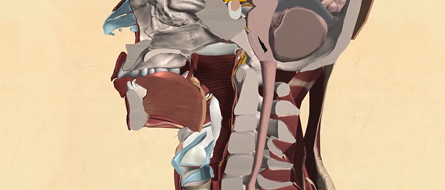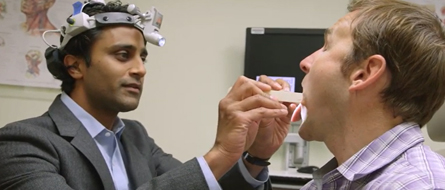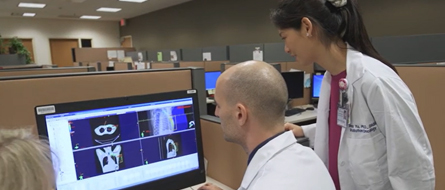What is oropharyngeal cancer?
Oropharyngeal cancer, also called oropharynx cancer, forms in the section of the throat behind your mouth. The oropharynx runs from the back of your mouth to your voice box (larynx) and includes the:
- Tonsils: C-shaped tissue in the back of the mouth that connects the top of the mouth (palate) with the back portion of the tongue
- Base of the tongue: Back part of your tongue that goes down into your throat
- Soft palate: Top of your mouth behind your back teeth
- Pharyngeal walls: Sides and back of the top of your throat
How does oropharyngeal cancer develop?
Oropharyngeal cancer develops when normal cells grow out of control. When these cells accumulate, they form a tumor in the oropharynx. Human papillomavirus (HPV) causes most cases of oropharyngeal cancer.
Connect to Care
Let us help find personalized care options for you and your family.
Symptoms of Oropharyngeal Cancer
In its early stages, oropharyngeal cancer may not cause symptoms. When symptoms do appear, they may include:
- A lump in the mouth, throat, or neck
- Bleeding from the mouth
- Coughing or choking when eating or drinking
- Difficulty opening the mouth, swallowing, or moving the tongue
- Ear pain
- Mouth pain
- Pain when swallowing
- Sore throat that doesn’t improve
- Unexplained weight loss
- White patches on the tongue or mouth
Oropharyngeal Cancer Risk Factors
Oropharyngeal cancer affects males and older people more frequently. Your risk for this head and neck cancer also goes up with:
- Human papillomavirus (HPV) infection
- Heavy alcohol use
- Poor dental habits, such as infrequent brushing and flossing
- Tobacco and marijuana use
- Unhealthy diet
Oropharyngeal Cancer Prevention
Because HPV causes most oropharyngeal cancers, getting the HPV vaccine can help in greatly reducing your risk. The Food and Drug Administration expanded the use of the HPV vaccine to prevent oropharyngeal and other head and neck cancers.
You can also reduce your chances of developing oropharyngeal cancer by:
- Avoiding tobacco
- Drinking alcohol in moderation
- Eating a nutrient-rich diet
- Visiting the dentist for regular check-ups
Types of Oropharyngeal Cancer
Several types of oropharyngeal cancer can start in the oropharynx:
Salivary gland carcinoma
This type of oropharyngeal cancer usually starts in the roof of the mouth. Minor salivary gland carcinoma can develop anywhere in the hundreds of tiny salivary glands in the mouth or throat.
Main subtypes of salivary gland carcinoma include:
- Adenoid cystic carcinoma: An uncommon type of head and neck cancer that can affect the major salivary glands or minor salivary glands.
- Mucoepidermoid carcinoma: The most common type of salivary gland cancer, which typically start in the parotid glands, the largest glands located in front of the ears.
- Polymorphous low-grade adenocarcinoma: A typically slow growing, curable cancer that’s more common in females.
Squamous cell carcinoma
Squamous cell carcinomas are the most common type of oropharyngeal cancer. The name comes from the thin, flat squamous cells that line the inside of the mouth and throat. Squamous cells help us breathe, eat, speak, and swallow.
Lymphomas
Lymphomas can start in the immune system or lymphoid tissue found in the tonsils and at the base of the tongue. The two main types of lymphomas that develop in the head and neck are Hodgkin lymphoma and non-Hodgkin lymphoma.
Oropharyngeal Cancer Stages
The stage of oropharyngeal cancer indicates the amount of cancer present and helps guide your treatment plan. Several factors play a role in the staging process, including:
- The tumor’s size
- Presence of cancer in the lymph nodes of the head and neck
- Whether the cancer has spread to other parts of the body
At Stanford Health Care, our specialists perform a thorough evaluation to accurately diagnose oropharyngeal cancer. The assessment may include:
Imaging tests provide detailed pictures of the inside of your body. Your doctor may order several imaging tests that use various technologies, such as:
- Computed tomography scan (CT scan) uses special X-ray and computer equipment to create images of bones, tissues, and organs.
- Magnetic resonance imaging scan (MRI) uses powerful magnets, radio waves, and a computer to create pictures.
- Positron emission tomography (PET scan) measures functions such as blood flow and oxygen use to show how the body is working.
- PET/CT scan combines PET and CT technology to show highly detailed images.
If imaging tests suggest you have oropharyngeal cancer, your doctor may order a biopsy of the tumor. A biopsy takes a tiny sample of cells from abnormal areas to check for cancer. We use several types of biopsies, including:
- Needle biopsy: Your doctor inserts a very thin needle (fine needle aspiration) or a wider needle (core biopsy) into a tumor, such as a suspicious lymph node.
- Image-guided biopsy: A radiologist uses an imaging technique such as ultrasound or MRI to guide the needle for the biopsy.
- Endoscopy: Your doctor inserts a thin, flexible fiber optic tube down the nose or throat to collect a sample.
- Surgical (or excisional) biopsy: Your surgeon may remove all or part of a tumor to be tested.
Before and during treatment, we take small samples of your blood to test in the lab. Blood tests provide information about your baseline health and help us monitor any potential side effects of treatment for oropharyngeal cancer.
Oropharyngeal Cancer
Our doctors specialize in diagnosing and treating oropharyngeal cancer, a type of head and neck cancer, using new surgical and nonsurgical treatments.
Head and neck cancer
squamous cell carcinoma
HPV






